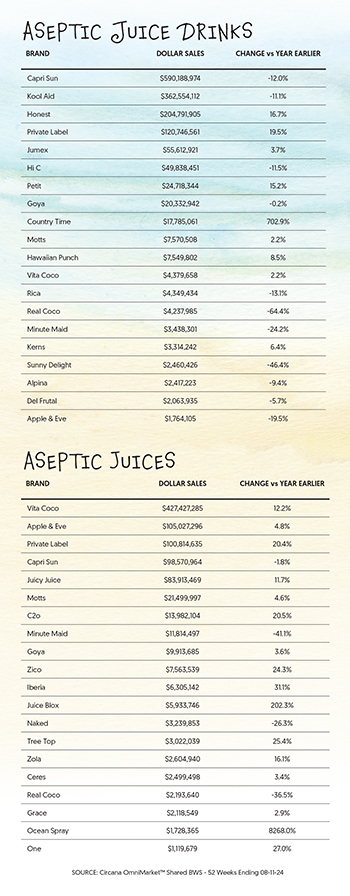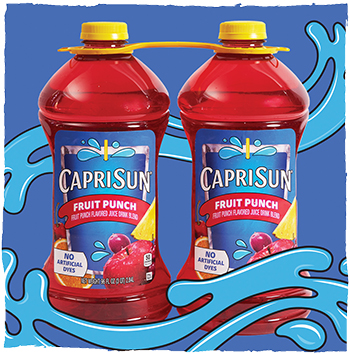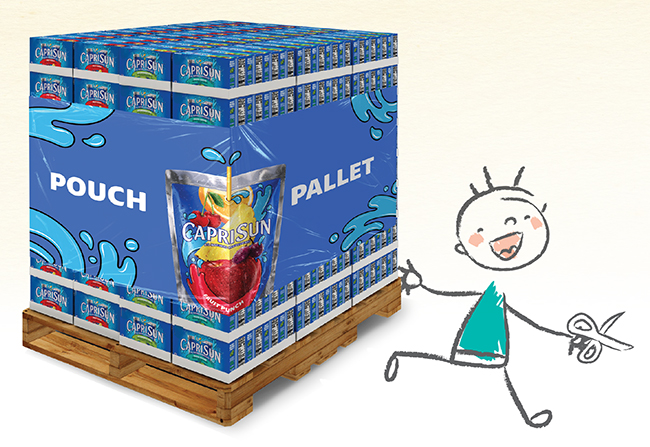Pouch Paradise: How Capri Sun Dominates Kids Drinks
A few weeks ago, anticipating that I actually was going to have to write this story (I’d assigned it to myself, after all), I reached out to Kraft Heinz for some of their thoughts on Capri Sun.
I asked them what had made Capri Sun such a success within their portfolio, particularly after the company bought it in 1991.
“Capri Sun has always been an iconic brand beloved by families, with a unique product offering that sets it apart in the kids’ beverage category,” replied Jordan Mann, a brand manager with Capri Sun.
“Always.” That stuck with me, because it echoed the reason for the story – how this brand, with its notoriously difficult to insert straw, grew to become such a strong presence in our lives. Beyond the philosophical, of course, because this is, after all, a publication covering the beverage trade, I wanted to understand the strategic and tactical underpinnings of the brand that keeps consistently above the competition. Instead, I got that word: Always.
If you want to see the numbers, look at our included chart with data from Circana on Aseptic Juice Drinks (page 52). Capri Sun’s right where it always is: a 40-plus share, with sales north of $500 million, followed by Kool-Aid, whose Jammers and Bursts are also part of the Kraft Heinz beverage empire, covering a whopping 70-ish share. We’ve been getting those numbers from Circana (nee IRI) for almost 20 years now, and I’ve looked as far back as I could; channel coverage has changed, but the proportions haven’t. No matter who takes a run at them – Minute Maid, Hi-C, Vita Coco Kids, V-8 (yes, V-8), Tropicana – Capri Sun stays on top.
Always.
I’m 52 years old. I grew up in the South, one of the first regions where Capri Sun was test marketed by Sarah Lee-owned Sunkist in the 1970s, after the company bought the North American rights to the brand. So maybe my opinion is a little skewed, as I’m in my sixth decade with the stuff. I gave up on the straw long ago, by the way, and like many adults, I have to use scissors to get inside the Capri Sun pouch.
Still, we’re in an era where attention spans are short. Tumblr feeds are considered throwback and Brittney Spears is old school, so maybe six decades of Capri Sun pouches, still packed 10 to a cardboard tray, plugged into Walmarts, club stores and supermarkets, planted on lunchroom trays, doled out with peanut-butter-and-honey sandwiches on camping trips and pulled not-quite-cold out of Igloo coolers during soccer game timeouts is pretty much “always.”
It’s in the Bag
Ah, the pouch. It’s a classic bit of intrapreneurship, that pouch. The brand was launched by multinational flavor company Wild Flavors, started in Germany nearly a century ago, and that pouch – a gusseted, stand-up amalgamation of plastic and foil, called a Doypack after its French founder, Louis Doyen, was originally used to hold the flavor concentrates that Wild would ship to its clients, until one of Wild’s engineers realized it could also be used as a single-serve conveyance. He was right. In the late 1960s, the brand took a fruit juice concentrate, added water, and started the brand, named to evoke the idyllic style of the Italian isle of Capri.
Maybe I wasn’t bright enough to ask where the straw came from, maybe I just never want to think about the straw again. Certainly, Kraft executives spent too much time thinking about it in the early 1990s, after they bought the brand for around $130 million. Over a five-year-period, a former Kraft executive told me, the company spent millions on attempts to make it easier to help kids take a slightly pointy, hollow reed and jam it through a target roughly the size of a ladybug. Aside from a little bit of a change at the point of entry to make it easier for the straw tip to pierce the target, it was largely unsuccessful.
The current management tries to pass it off as a delightful feature, but we know better.
“We see the straw as one of the reasons Capri Sun pouches are so fun to drink and the perfect way to sip every last drop!” said Mann. “Poking into the pouch is a unique part of the Capri Sun experience, and we know fans love it. Some people even drink it upside down or sideways – it’s all part of the fun!”
In 1991, Kraft – or, at the time, the beverage division of General Foods, part of the merged food business of Kraft and General Foods that was being combined by owner Philip Morris – was trying to build out its beverage offerings. It was great at powdered tubs – think Kool-Aid, Country Time, Crystal Light, Tang – but only had a slight presence in the liquid, single-serve space from Kool-Aid Bursts.
That changed with Capri Sun, which had actually languished a bit in the mid-1980s. It had revenue of about $100 million when Kraft bought it, according to a story in the Chicago Tribune, but its trajectory had flattened in the 1980s when Sara Lee unloaded Shasta on National Beverage. In 1985, Capri Sun became an independently run subsidiary, still the largest pouch out there, but the development of aseptic juice boxes for brands like Hi-C and Kool-Aid had cut into its leadership position among all kids drinks.
It turned out to be $130 million well spent.
Just how much growth? Did you see that I wrote Philip Morris? That’s right. In the course of reporting this story, I managed to end up sorting through evidence from the landmark 1998 tobacco settlement, the one between several state attorneys general and the country’s biggest tobacco companies (something about being really good at marketing to kids). In a trove of files stored online by UCSF, there’s a presentation from 1996 detailing just how big an impact the brand had on Kraft’s fortunes after the pickup.
Between 1992 and 1995, according to the presentation, Capri Sun was the top selling aseptic juice drink in the U.S., regardless of package – and was 80 percent of the beverage division’s income from operations. By 1996, according to the presentation, Capri Sun’s sales volume was eight times higher than its purchase price had been.
“Following the acquisition, the goal was to provide the resources, scale and infrastructure that would allow the brand to reach new heights,” notes Mann. “The expanded distribution network allowed Capri Sun to become even more accessible to families across the country. Our focus on consumer insights and innovation enabled us to introduce new product lines and cater to evolving preferences unlocking growth.”
But why has it been able to hold off all of the competition? Observers and competitors made it clear that it’s the combination of scale and price that keeps it at the front of the pack. You know that chart we’ve all seen that shows that most of the food in the world is owned by about 10 brands? Kraft Heinz is one of them, and they aren’t giving up on this one.
Here’s one of those competitors, Seth Goldman, the founder of Honest Tea, which eventually begat Honest Kids, one of the few brands to eat into Capri Sun’s share in recent years (being owned by Coke helps, but so does having a clear launch pad in Whole Foods, one of the few places that doesn’t sell Capri Sun).
“True confessions,” said Goldman, an organic advocate, vegan, Ironman triathlete, and one of the healthiest humans in Maryland. “I was buying it for my own kids – it’s whatever was on sale. I’m the lunchbox maker, and I wasn’t thinking.”
Eventually, one of his sons asked for Honest Lemonade, and Goldman, showing a talent for familial intrapreneurship, ended up with Honest Kids, a product that he thinks might eventually catch up to Capri Sun. One thing that he grasps – the key issue around the product isn’t that kids love it, it’s that they’ll accept it. Make that choice easy for the parents, and it’s easy to understand the dominance.
“It’s got the scale, it’s got the shelf space, and it works for what it is,” Goldman said. To beat Capri Sun, “you’ve got to get a foothold somewhere and really succeed. For us, that natural channel was the perfect place to start – buyers trusted us to have something meaningfully different. But no one’s going to beat Capri Sun with the same set of ingredients and a differently colored pouch.”
Brand Maintenance
Goldman takes pride in the idea that his product – organic juice that’s watered down to reduce calories and sugar – was different enough, and powerful enough, to actually cause Capri Sun to take notice. The juggernaut altered its formula, reducing sugar and calories in its own products.
That’s something I asked Capri Sun about as part of my attempt at a master class in brand maintenance. It did seem like they’d evolved a bit. Here’s what they told me:
“The beverage space has transformed tremendously over the years, and Capri Sun has evolved with it,” Mann said. “As consumer preferences shifted towards natural ingredients and lower-sugar options, we’ve been a part of that change. We switched to all-natural ingredients, introduced our 100% Juice line, and launched Roarin’ Waters, a flavored water option to cater to different households’ sugar preferences. “
I asked a lot of questions of Kraft Heinz about the kind of tactical, operational moves it makes to control the market, but obviously, they felt free to not spend their time sharing that with the likes of me – or you. They’ve invested millions into making the pouches, squeezing nickels for margin and streamlining operations.
But it’s the “always” part that seems to be more important than many of those technical details. As a media company and an industry that – rightly or wrongly – tends to focus closely on innovations, functions, and things that generally look to the future, there’s something to be said for the power of the past and the present.
“Like Gatorade, they have cemented themselves as a pillar in the category that’s built on consumer occasions,” said Pat Bolden, CEO of Plezi, a new kids brand that’s aiming to provide a healthier alternative to juice. “Lunch, parties or kids outings.”
Recently, two ripples appeared in the relatively placid Capri Sun news stream. First, a rumor surfaced over the summer that the Wild family was looking to raise about $500 million to buy back the North American rights to Capri Sun, potentially to consolidate the brand’s international portfolio for eventual sale. Deal buzz has gone cold since then – and Kraft Heinz isn’t discussing it, of course.
But in August, we found something even more shocking: an innovation. Last month, a leaked photo of a bottled, single-serve version of Capri Sun briefly knocked the internet on its butt. The idea seemed reasonable from an industry standpoint, but it sent relative shockwaves through some circles of social media, which immediately took up tweets against the potential betrayal of their memories: Could this bottle mean the brand was moving away from pouches?
Dozens of production lines say no, but the outcry – led by the New York Post and its online kissing cousins at Barstool Sports – was whiny but brief. While it was handled quickly by a mollifying shipment of giant Capri Sun pouches to Barstool’s offices, it nevertheless highlighted the pouch-shaped imprint that Capri Sun has left in the childhood memories of so many consumers.
And that’s something that Mann did discuss.
“It’s clear through the strong reaction we saw to the rumor about our pouches being phased out shows how much Capri Sun means to our fans,” she said. “It’s part of childhood for so many – whether that’s at birthday parties, after-school snacks or soccer games. For Millennials and Gen-Z it’s nostalgic and that connection runs deep. We knew we had to act quickly to reassure everyone that our pouches weren’t going anywhere.”
Even if bottles show up, those pouches, they’ll be here forever. And always. Bring scissors.


Receive your free magazine!
Join thousands of other food and beverage professionals who utilize BevNET Magazine to stay up-to-date on current trends and news within the food and beverage world.
Receive your free copy of the magazine 6x per year in digital or print and utilize insights on consumer behavior, brand growth, category volume, and trend forecasting.
Subscribe



